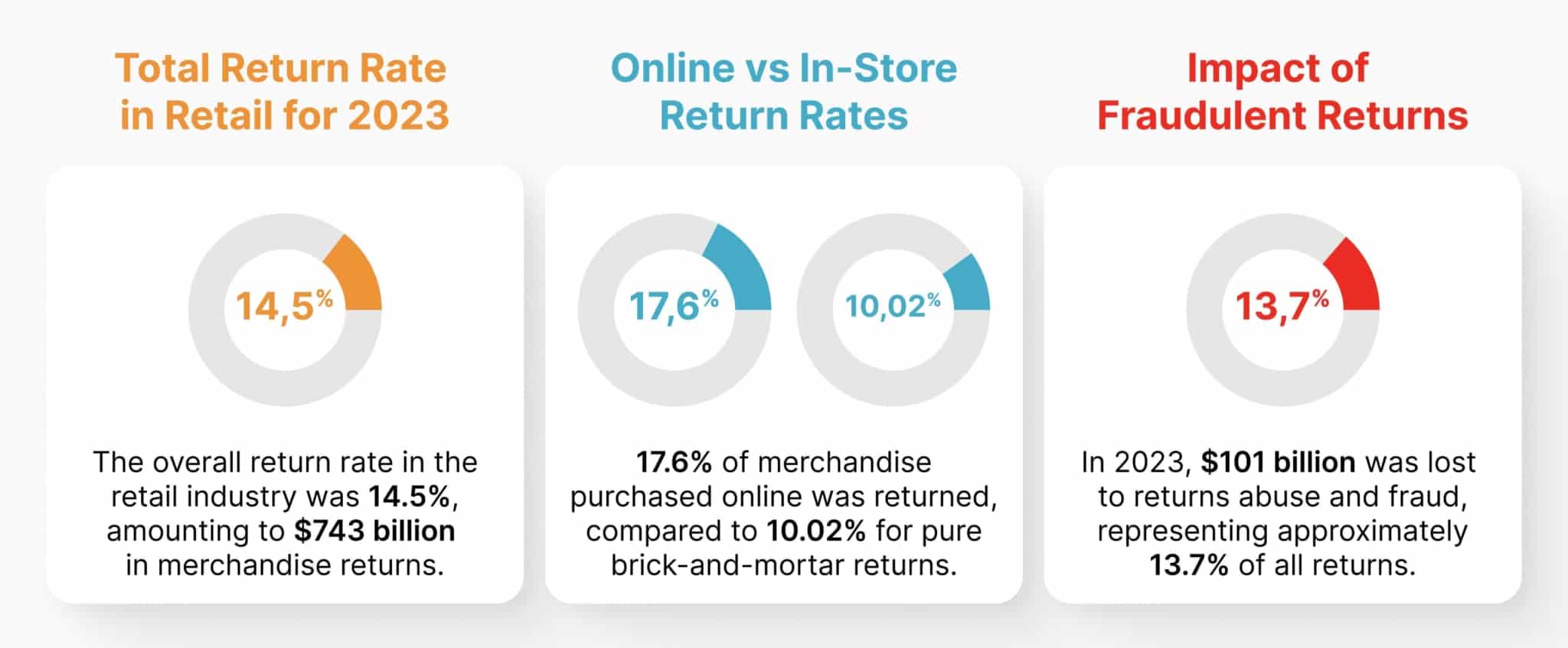Rising Online Returns Dilemma: Challenges and Solutions for Retailers

In the dynamic realm of e-commerce, retailers are forced to navigate a constantly growing surge of online returns. This trend, driven by the widespread adoption of online shopping, brings several challenges that are reshaping the retail landscape. From the challenge of efficiently managing reverse logistics to the financial implications of handling returns, this rise impacts various aspects of your business.
To complicate matters, the simplicity and flexibility of online shopping have led to a notable increase in customer expectations regarding returns. Customer feedback can provide valuable insights into why returns are happening and help improve the return process. This shift has a profound effect on inventory management, customer relations, and, ultimately, your bottom line.
Understanding Online Returns
1. The Growing Trend of Online Returns and Its Effects on Retailers
The surge in online shopping has brought with it a significant increase in online returns, with return rates averaging between 20% to 30%. This growing trend is reshaping the retail landscape, presenting both challenges and opportunities for retailers. The ease of purchasing and returning products online has heightened customer expectations, making it imperative for retailers to adapt.
The effects of online returns on retailers are multifaceted. Financially, the costs associated with processing returns can be substantial, impacting profit margins. Additionally, frequent returns can lead to inventory management issues, as products may not be resold or restocked promptly. Beyond the financial implications, there is also the risk of reduced customer satisfaction and potential damage to brand reputation if the return process is cumbersome or unsatisfactory.
To navigate these challenges, retailers must develop effective return policies and strategies that prioritize customer experience and satisfaction. By doing so, they can turn the challenge of returns into an opportunity to enhance customer loyalty and retention.
2. The Cost of Processing and Handling Returns
Processing and handling returns is a costly endeavor for retailers. Studies indicate that the average cost of processing a return is around $10, with some retailers reporting costs as high as $20. These expenses encompass labor, shipping, and restocking fees, which can quickly accumulate and erode profit margins.
Moreover, returns can create inventory management challenges. Returned products may not be resold or restocked in a timely manner, leading to potential losses. To mitigate these costs, retailers must implement efficient return processes. This could involve automating parts of the return process or outsourcing return handling to specialized providers, thereby reducing the burden on internal resources and improving overall efficiency.
3. The Impact of Returns on Customer Loyalty and Retention
Returns play a crucial role in shaping customer loyalty and retention. A positive return experience can significantly enhance customer satisfaction and foster loyalty, while a negative experience can drive customers away. According to market research, 39% of customers are more likely to shop with a retailer that offers a hassle-free return experience. An even larger percentage of customers are less likely to return to a retailer that requires cumbersome mail returns.
To prioritize customer loyalty and retention, retailers must develop return policies and strategies that prioritize customer convenience and satisfaction. By offering a seamless and positive return experience, retailers can build trust and loyalty, ultimately driving repeat business and increasing revenue.
The Challenges of Online Returns: By the Numbers
Shopping has undergone some considerable changes since the beginning of 2020. With a massive shift toward e-commerce over traditional brick-and-mortar stores, it is no surprise that we’re seeing a rise in product returns as well.
Here are the most recent stats for Online Returns, according to the National Retail Federation (NRF).
- Total Return Rate in Retail for 2023: The overall return rate in the retail industry was 14.5%, amounting to $743 billion in merchandise returns.
- Online vs In-Store Return Rates: 17.6% of merchandise purchased online was returned, compared to 10.02% for pure brick-and-mortar returns.
- Impact of Fraudulent Returns: In 2023, $101 billion was lost to returns abuse and fraud, representing approximately 13.7% of all returns.
These numbers paint a vivid picture of retailers’ challenges when processing returns. When said and done, US companies alone processed $173 billion in returns. High return rates can lead to increased customer churn, making it essential to address this issue to maintain customer retention. As the e-commerce industry continues to evolve, understanding and adapting these trends becomes crucial for maintaining customer satisfaction and ensuring business sustainability.

Harnessing Technology to Transform Returns
In the face of these return-related challenges, technology stands out as a beacon of hope. Advanced technological solutions are revolutionizing how retailers manage and process returns, turning a complex challenge into an opportunity for efficiency and customer satisfaction. By streamlining business processes, companies can reduce the costs associated with handling returns and improve overall operational efficiency. Here’s how technology is making a difference:
1. Returns Management Systems (RMS)
Systems like ReverseLogix offer a comprehensive solution for managing returns. RMS can automate the return process and auto-route returns from initiation to final disposition, making it more efficient and less prone to errors.
This includes automated RMA (Return Merchandise Authorization) generation, real-time status updates for retailers and customers, and streamlined processing at the warehouse. Furthermore, RMS can be tailored to a retailer’s specific return policies and procedures, offering a customizable return approach. This not only enhances operational efficiency but also ensures a consistent customer experience.
2. Data Analytics and Customer Feedback Insights
Leveraging data analytics in returns management goes beyond mere number crunching. It’s about gaining actionable insights into why customers return products and the returns policy that guides these returns. Is it due to size issues, product quality, or misleading product descriptions? More important for some of these e-commerce platforms is the cost of these returns on their bottom line.
Analyzing return data can also impact the net promoter score by identifying areas for improvement in the return process. Understanding these patterns can inform various aspects of a business, from product development to marketing strategies. Analytics can also predict return trends, helping businesses to proactively manage inventory and resources. This foresight minimizes disruptions and keeps the supply chain agile and responsive.
3. Automation in Handling Returns
Automation technologies streamline the return process, reducing staff workload and speeding up the return-to-resale cycle. This not only speeds up the process but also reduces environmental impact by promoting sustainable practices.
Automation can enhance customer interactions by providing timely updates and reducing wait times during the return process. Automated systems can also integrate with customer service platforms, providing immediate responses to common queries and freeing human agents to handle more complex issues.
4. Integration with Supply Chain
Effective returns management is not an isolated process; it’s an integral part of the broader supply chain. Integrating RMS with other supply chain components – like inventory management, order fulfillment, and logistics – creates a cohesive ecosystem.
Integrating RMS with the supply chain can provide a seamless experience throughout customer journeys, from purchase to return.
This integration allows for the seamless flow of returned products, refund information, and resources, enhancing overall supply chain resilience. The integrated approach also provides end-to-end visibility, making tracking products throughout their lifecycle easier, which is vital for operational efficiency and customer satisfaction.
5. Improving Customer Experience Strategy
Technology is a powerful tool for enhancing customer experience (CX) in the returns process. AI and machine learning can personalize the returns experience, offering customers options based on purchase history, preferences, and payment (including credit or debit card).
Chatbots and virtual assistants can guide customers through the return process, answering questions and providing real-time updates. This not only improves the customer experience (CX) but also builds trust and loyalty.
By leveraging technology, businesses can manage returns more efficiently and gain valuable insights to reduce return rates and improve customer satisfaction. Technology integration in the returns process has become necessary in the modern retail landscape.
By understanding customer needs and expectations and incorporating such technology-based solutions, companies can build a comprehensive customer experience strategy. This will ultimately result in reduced return rates, improved customer satisfaction, and increased revenue.
Turning Challenges into Opportunities with ReverseLogix to Boost Customer Loyalty
In an era where returns are higher than ever, efficient customer experience management is crucial to provide a positive customer experience. The right approach can enhance customer satisfaction, streamline operations, and contribute positively to a business’s bottom line. A positive return experience can attract new customers through word-of-mouth and positive reviews.
Embracing innovative solutions and adapting to changing consumer behaviors are key factors in turning the challenge of returns into a strategic advantage. Partnering with a solution like ReverseLogix can make a substantial difference.
Here are a few general benefits of working with ReverseLogix:
- Streamlined Returns Process: Their system automates and simplifies the returns process, making it more efficient and user-friendly.
- Data-Driven Insights: ReverseLogix provides valuable analytics that help understand return patterns and customer behaviors, enabling more informed decision-making.
- Seamless Integration: It integrates smoothly with existing supply chain operations, ensuring a cohesive approach to returns management.
Incorporating a specialized returns management system like ReverseLogix addresses current needs and prepares businesses for future shifts in the e-commerce landscape.
